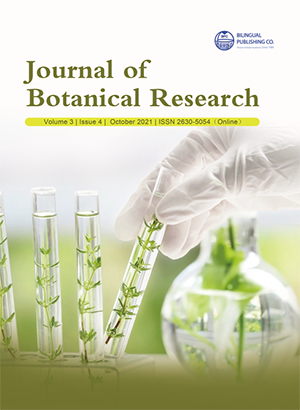-
219
-
214
-
161
-
153
-
152
Assessment of Coffea Shade Value through Comparison of Mountainous Area with Farm Land Coverage, in Arsi Gololcha District, Oromia, Ethiopia
DOI:
https://doi.org/10.30564/jbr.v3i4.3586Abstract
Coffea cultivation with shade tree is used for improving soil health, increasing coffea production, sustaining agro ecology. The study was attended in two kebele, on 36 farmers’ fields, at Gololcha district of East Arsi zone. The study was intended to assess the influence of coffea shade trees on farm lands versus mountainous area. Household interviews were used to get imperative separately, i.e. from old farmers, middle age farmers and young farmers. Significant difference value was observed between farm land and mountainous area coverage. Based on this respondents’ idea, before 25-30 years; the ‘condition of tree coverage at mountainous’ area in Arsi Gololcha district was ‘medium condition’ but not normal that means as deforestation of mountainous area have been starting before 30 years’ time; while the condition of tree coverage at farmland area also has been starting before 30 years’ time. The third respondents’ idea was interpreted with the real situation of the district, that it gave us a constructive inspiration on the role of coffea shade tree to enable the farm land to be taken as regular natural forest. The existing coffea shade trees are Cordia africana followed by Erythrina abyssinica and Acacia senegal. Farmers accounted 95% of coffea shade users and 4.6% without shade users. The respondents said that even if the rainfall intensity is increasing at farmland rather than mountainous area occasionally due to shade tree effect. On the contrary side, mountainous area exposed to deforestation since the farmers have been shifting to hilly side for their livelihood dependency.Keywords:
Farm lands versus mountainous areas; Ecological value of Coffea shade treesReferences
[1] AfDB, 2010. Boards of Directors of the African Development Bank and the African Development Fund. Covering the period January 1 to December 31, 2010.
[2] Albertin, A., Nair, P., 2004. Farmers’ perspectives on the role of shade trees in coffea production systems: an assessment from the Nicoya Peninsula, Costa Rica. Human Ecology 32 (4).
[3] Calvo, G. and Platen. H. 1996. Cacao-laurel-plátano. Costosy beneficios financieros. Serie Técnical Informe Técnico. No.264.CATIE, Turrialba, CostaRica.
[4] FAO State of Food and Agriculture Report, 2007. FAO Economic and Social Development Department,CorporateDocumentRepository.http://www.fao.org/docrep/010/a120e/a1200e00.htm> (accessed 27.11.09).
[5] ICO. 2001. International Coffea Organization. The Global Coffea Crisis: A Threat to Sustainable Development. URL: http://www.ico.org.
[6] Idol, T. and Youkhana, A. 2010. Managing Shade Trees for Coffea Can Benefit the Soil. Hānai‘Ai / The food Provider. College of Tropical Agriculture and Human Resources, University of Hawai, Manoa.
[7] Izac, A., 2003. Economic aspects of soil fertility management and agroforestry practices. In: Schroth, G., Sinclair, F.L. (Eds.), Trees, crops and soil fertility: concepts and research methods. CABI, Wallingford, UK, p. 464.
[8] Garrett, H., McGraw, R., 2000. Alley cropping practices. In: Garrett, H., Rietveld, W., Fisher, R. (Eds.), North American Agroforestry: An Integrated Science and Practice. ASA, Madison, pp. 149-188.
[9] Garrity, D., 2004. Agroforestry and the achievement of the millennium development goals. Agroforestry Systems 61, 5-17.
[10] Moguel, P., Toledo, V., 1999. Biodiversity conservation in traditional coffea systems of Mexico. Conservation Biology 13 (1), 9-25.
[11] LeCoq, J.F., Soto, G., González, C., 2011. PES and Eco-labels: a comparative analysis of their limits and opportunities to foster Environmental Services provision. In: Rapidel, B., DeClerck, F., Le-Coq, J.F.,Beer, J. (Eds.), Ecosystem Services From Agriculture and Agroforestry: Measurement and Payment. Earthscan, London, UK, pp. 237-264.
[12] Nai Nair, P., Kumar, B., Nair, V., 2009. Agroforestry as a strategy for carbon sequestration. Journal of Plant Nutrition and Soil Science 172, 10-23.
[13] Soto-Pinto, L., Perfecto, I., Castillo, H., Caballero, N., 2007. Shade effect on coffea production at the northern Tzeltal zone of state of Chiapas, Mexico. Agriculture, Ecosystems and Environment 80, 61-69.
[14] Perfecto, I., Vandermeer, J., 2006. The effect of an ant-hemipteran mutualism on the coffea berry borer (Hypothenemus hampei) in southern Mexico. Agriculture, Ecosystems and Environment 117, 218-221.
[15] Harvey, C., Medina, A., Merlo Sánchez, D., Vilchez, S., Hernández, B., Sáenz, J., Maes, J.M., Casanoves, F., Sinclair, F.L., 2006. Patterns of animal diversity in different forms of tree cover in agricultural landscapes. Ecological Applications 16 (5), 1986-1999.
[16] Williams-Guillén, K., Perfecto, I., Vandermeer, J., 2008. Bats limit insects in a Neotropical agroforestry system. Science 320 (70), 5872.
Downloads
How to Cite
Issue
Article Type
License
Copyright © 2021 Author(s)

This is an open access article under the Creative Commons Attribution-NonCommercial 4.0 International (CC BY-NC 4.0) License.




 Alemayehu Diriba Roba
Alemayehu Diriba Roba





